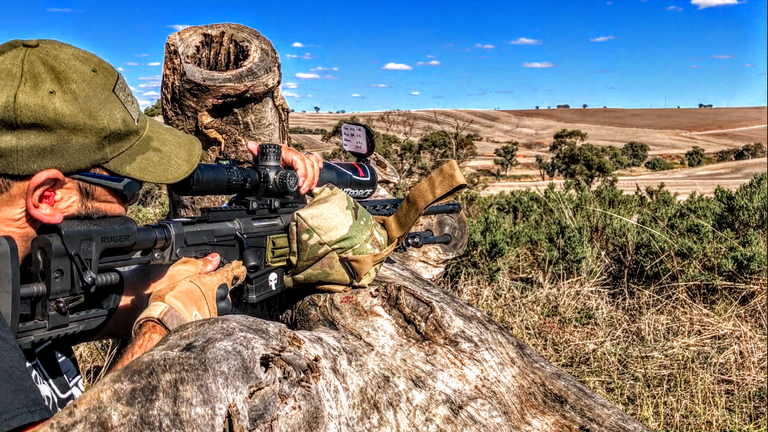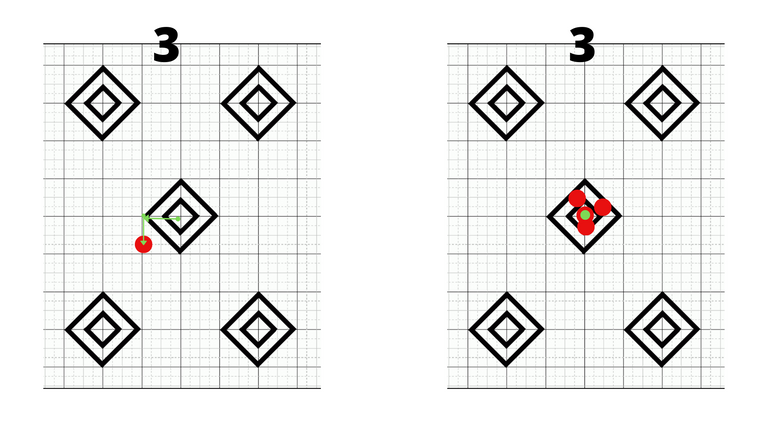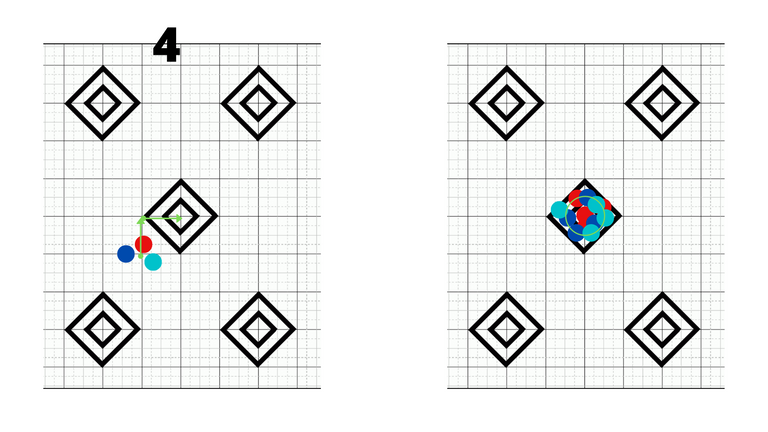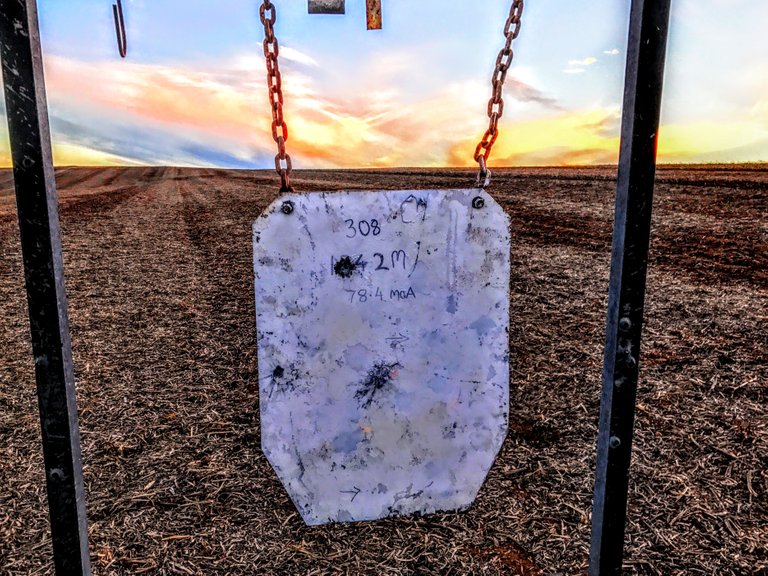Cold bore dope
I've been shooting rifles for a long time, some thirty years, and over that time I've shot in many environments and situations. Over that time the range at which I would shoot, wanted to and needed to shoot, got greater and greater - Targets at 1600+ meters (a mile or more) is not unusual and there was a steep learning curve, a lot of training and practice, to gain the skills to do so.
Many things come together to make a long range shot accurately, first time, and I've written about it in the past; You can scroll through The Pew Community to see some of my previous posts on the topic if you like.
It can get technical, as my posts will demonstrate, but getting the round accurately onto the target on the first shot can be critical in certain circumstances, low percentage exposure engagements for instance, and the elements that make that happen are equally as important as each other and understanding what one's rifle will, or may, do in any situation is critical to that first-shot accuracy.
It's for this reason marksmen collect data; It's called data on previous engagements or simply dope.
In my experience there's one area that many shooters neglect when it comes to dope and that's what their rifle's do in a cold bore scenario. The concept is called cold bore shift and for any serious long range shooter it's critical to understand, in my opinion anyway.

Cold bore shift
This simply refers to the deviation between the point of impact and the point of aim which occurs when a rifle is fired in a condition when it is at the same temperature as the ambient temperature - i.e. The ambient air temperature is 5 degrees Celcius and the bore/barrel/rifle is also.
When the first round is fired the bore heats up and with more shots the heat becomes greater than ambient which could bring a change to the dimensional characteristics of certain parts like the barrel, bolt, action and so on. That can affect the subsequent shots.
Essentially, the second and subsequent rounds could impact the target in different locations than the very first cold bore round, even when the point of aim is exactly the same. Not knowing how one's rifle performs in different cold bore scenarios could mean that first fired round could result in a miss.
This is one of my steel gongs. See that impact at almost dead centre? That's a cold bore shot I made late evening at 1400 meters or so. I never miss the chance take a cold bore shot at a decent range to check dope I've collected previously. The idea is that I use the process below to gain the dope for shots like this.
Due to the possible deviation as mentioned above I have always gathered data on my cold bore shots...It's called mapping and is done as follows.
- 1 - Make sure rifle is at ambient temperature, has a fouled bore (see below re: fouled bores), and turrets are set to zero zero (no elevation or windage input). Shooting from the prone position (the most stable) fire a single round at the left target.
- 2 - Shift aim right and fire four rounds at the right target to obtain a mean point of impact (POI). Clearly the shooter needs to aim at dead centre in both cases.

- 3 - Measure the angular deviation present from the mean POI of the last four rounds on the right target to the first round on the left target. This can be done using the reticle or by heading down range and using an MRAD ruler. (Mean POI and angular deviation in green below.)

4 - Repeat this process, being careful to make sure that the rifle is at the ambient temperature prior to beginning, to determine the average cold bore shift compared to the average mean point of impact. One is left with an average angular deviation which can be compensated for with dialling elevation and windage or holding over together with ballistic solutions - I use StrelokPro for my ballistic solutions.
Below you can see the two subsequent shot-groups, so three in total, and the average angular deviation to the centre of target on the left which is what would be measured and then compensated for. It is better that more than three tests are done for the best results, I usually do four to five but have done up to ten.

Above adjustment would be something like UP 0.5 MRAD and RIGHT 0.4 MRAD (Figures used for demonstration purposes only and are not accurate).
My long range rifles show a cold bore deviation although some rifles do not. The complication is that it's impossible to know how a rifle will perform in a cold bore condition without the mapping. It is critical to shot placement that the marksman knows how his or her rifle will perform in a cold bore condition, and failure to do so can be catastrophic especially during engagements where that initial shot needs to count. There are so many variables when shooting and a rifle with undocumented and unknown cold bore performance is most often going to let the marksman down.
There are a couple of other conditions I want to briefly mention here. The first is not a position a marksman should find himself/herself in when in the field as it is completely avoidable and the second...Well, that's why we train and practice.
Clean bore shift is inconsistency/deviation between the point of impact and the desired point of aim which occurs after a rifle has been cleaned. The cleaning process removes copper and carbon build up changing the dimensions of the bore. Cleaning products can also bring inconsistencies in the friction-coefficient of the bore...This is why I mention above that the cold bore mapping process requires a fouled bore - A bore that has had several rounds fired through it. I would never take a rifle into the field in this condition...Although I have dope from my rifles immediately after cleaning in the advent it was to happen.
Finally is the cold shooter inconsistency. This is basically the inability of the shooter to operate the rifle consistently: Head and eye placement, trigger-pull processes, breathing and body position are all vitally important to an accurate shot, cold bore or otherwise. Practice and training makes one better so this situation is completely avoidable.
OK, so 1100+ words...Sorry, it's long huh?
I guess my point here is that shooting isn't all about drinking a case of beer and heading out to the back yard and blowing away watermelons, pumpkins and cans. It is science really, and a glance over some of my other posts will clearly demonstrate that.
Just a note, this is a cut down explanation of the cold bore concept and process of mapping. I don't like to over-complicate matters when there's an easy way to do things. Having said that there are things I've left out to make this a little more readable...So, it's not designed to be the definitive guide to cold bore ballistics - It's just a little post I threw together for fun.
Thanks for reading.
Design and create your ideal life, don't live it by default - Tomorrow isn't promised.
Be well
Discord: galenkp#9209

So what is the scale on those images? How far is the cold bore shot from center in cm?
I never measure in centimetres, I always use MRAD as that's what my reticle is. Also, I made those images up for illustration purposes only and they are not actual shot-groupings.
MRAD (Millradian) or MOA (Minute of angle) are units used for angular measurement and centimetres are not used by shooters, or should not be.
So an adjustment value in a rifle sight (the ones I use) in MRAD is 1 cm at 100 meters which equals
10 mm/100 m = 1/10th MRAD. My scope adjustments for elevation and windage are 1/10th for each click. The table below is a field firing solution from my ballistic calculator. It shows MRAD adjustments and I've added the inches as well. It's pretty obvious why distance measurement is not used for scope adjustments.
Look at the elevation adjustment for 1000m...U335.3 inches. It wouldn't be possible to show that adjustment on a scope...8.5 MRAD though is.
Sorry, it can get a bit complicated. As far as shot groups go...At 100 metres, using my long range rifles I would expect to be putting the rounds so close to each other that they looked almost hole in hole...If they looked like a tight clover leaf I would be disappointed. Five shots should look almost like a single hole or there abouts so all in the space of about 0.5cm or so.
I have never measured POI of a cold bore shot in centimetres and am a bit reluctant to say a number as it would probably be wrong. A few centimetres comes to mind.
The reason I was interested is those few cm could mean a miss when culling roo's, if shooting with a cold bore.
Oh yeah, for sure. A centimetre at 100m is way more at 500m.
When culling my first shot is always cold bore because I'm not about to fire a round or two to warm up the bore in that environment - A sniper wou;dn't do that either...So, it's really important to know what that cold bore shot will do. So, you're exactly right.
Well, I just know arms from shooting in Call of Duty. But it is very interesting to see they are very similar in cold conditions to musical instruments. As cold tends to get instruments out of tune and you need to give them time to temper to the cold. This reminds me, if you ever go to a concert in a cold place and you see people who play wind instruments blowing into their instruments, it is because if they don't they won't make any sound when it is time to play.
Of course, this goes way from the point. I like the idea of keeping notes about performance in certain condition. Shooting a projectile at such a long range requires more precision of setting than actually firing the shot.
For a second then I thought you were going to say it's similar to call of duty. I am glad you did not.
The cold instrument thing is real though. I played the trumpet and bass guitar in a jazz band for a few years, many years ago, and cold affects the instrument as you say. Not so much the bass, but the trumpet for sure. My grandfather played the E-Flat bass in the town marching band for most of his life, in fact his brother was a renowned euphonium player here in Australia back in the day. (He cut records back in the 1920's which I have). Both would attest to your comment on the cold thing affecting their instruments.
I was nowhere near that good but could get a squeek out of my trumpet well enough not to get laughed at.
Temperature affects most things, shooting included.
Your last comment above...Seems like you have done some shooting; How long for and what?
I haven't shot anything in my life besides from Call of Duty. I just know some facts I have picked up from movies in which there are snipers. And also got some reading. Besides, I was good at physics and know how projectiles work (most of the time).
Well, more stuff to know about the G-Dog, also a brass player and jazz player. Man you've got some cool stuff to tell. Each time you tell me another story I feel like I'm 5 and I'm asking my grandfather about something from this town back when he was younger.
Movies huh? Well, seems like you've got it all covered.
I also read. So, that's also my source.
You might like this one:
Accuracy and Precision for Long Range Shooting - Bryan Litz.
Can I find that for free in any place? Because I can't afford buying books. PDF is sort of my religion. 🤣
Hmm, I'm not sure if it's in PDF, I only ever buy hard copies...Here's the site: https://store.appliedballisticsllc.com/category_s/103.htm
And I enyy you for that. In a good way, hahaha. That's money well spent. That's the way I would like to spend my money. And I actually did for some time before inflation got bunkers!
I'm lucky to be able to do so, I know. A lot of my books I get second hand so they are cheap, but the shooting stuff is so niche that I have to get them new. Besides, no one generally let's those books go once acquired.
I've been shooting for 30 years and would never say I know everything, or even close to everything, there is so much to know and projectiles change all the time, as do primers, powders and rifle technology but through training and education I have acquired a lot of understanding in those 30 years. I like the combination of reading and instruction...Learning from others, then applying it in the field. I guess one would say I know a little.
Well, that's the thing with everything. I think that's the wonderful things about us. Skills take so much to master and the fact that we can pass what we have learned to other generation and they can do the same is awesome.
And you are right. Reading is an excellent way of learning, but in this case is applying what you have heard, read and thought about what will give you the true understanding of these things.
It has happened to me back when I practiced Aikido and didn't understand a technique. I watched videos, read, asked my sensei, my senpais, and when I started to to do things and apply the principles, it was the "eureka" moment. I could finally fathom beyond the thing in words and bring it to the world.
Yep, reading something alone is ok in some cases but in many applications it's not going the best to do in isolation. A combination is the best. I've had a lot of training with firearms in my 30 years of shooting, have read so many books and have put in countless hours behind the gun...I can still only say I know a little.
And I guess you could write about with that little knowledge you have and it would be a good contribution to that niche.
Yeah, I think after 30 years I have something to contribute.
Remember to send a signed copy! 😂
Lol, I'm more hands on so my contribution would be practical in nature I think. I just wrote these posts for fun.
Oh, well. That is also worth checking out.
I'm a good teacher/instructor and only resort to beatings when fuckers don't listen. 😂
Ha, ha, ha. Nothing beats a good ol' fashioned beating when your attention is elsewhere or you are annoying. Conductism works so well I don't understand why it was abandoned! 😂
Ah yes, I can see you're well-versed in the ways of beatings as form of motivation or simply to gain someone attention. It's an age-old method, tried and tested, and if it ain't broke why fix it! 😆
🤣
Yeah, we learn about all that stuff in Educational Psychology but we are told that beating is not permitted. I mean "why not?" if it is the only method that has been tested for millennia and it's known to work.
It worked for the Spartans, Roman Empire, Attila the Hun, my headmaster at school,...So many others...I know it's frowned upon now but hey, maybe it's time to revisit the concept, deploy some beatings, and see what results can be achieved. I'm at my office right now...I might go and administer some motivational beatings...I think productivity is going to be on the up! 😂
Ha, ha, ha. I bet some good results could be at hand with that initiative! You to tell me how did it go. Did production went up? By how much? 🤣
Lol...Well, there was some crying, strangely mostly from the males, but after the crying (and bleeding) stopped they all seemed very keen to work, and avoid further motivational thrashings! 😂
Ha, ha, ha. Well, we have a lesser tolerance to pain, so it is not a surprise. Good thing they now know how to avoid the beating: just get good! Nice results from the experiment.
You see? A decent beating just gets the results! 😆
I'm more the kind of teacher that tells you to go do another thing if you're not motivated. That has to do with my learning style, but also because I don't like to see time wasted.
Well, my staff line up at my door for their daily beating - Some bring their own stick. I like those ones. Suck-ups! 🙂
Ha, ha, ha. I imagine the door says something like "Motivational beating are mandatory. Bringing tour own stick is optional"
Yep, it's something like that. Although...If I was really inspirational I'd motivate them to beat each other and I could put my feet up on the desk and relax more.
Ha, ha, ha. Well, those are some good ideas for the next line-up-motivational-beating set up. Keep getting your ideas in line for that.
Hmm, maybe I should run seminars, you know, teaching people how to motivate others. 🤔
Hey, it would be worth people's moneys! Not that stuff coaches say. Some true and tested methods for motivation. 😂
You know how I'd teach the teachers though right? Yep, with beatings!
Ha, ha, ha. I figured out as much! Reminds me of my sixth grade teacher. She had an aluminum ruler.
I was aware of cold bore deflection, but never gave clean bore a thought. I sighted my hunting rifles cold because that is how there were going to be used. They weren't always clean bore, though. Hmmmm.
Wildly different situation. A successful hunting season for me would be two cold clean shots. One deer, one elk. Not that that is exactly how it worked out ever, but that would be the goal.
I don't believe I ever took a shot over 300 meters, probably closer to 200. I really wanted 100 or less.
Interesting stuff that I never even considered.
Clean bore shooting is not suggested. I mean two to three shots in and you're not clean bore anymore. Good to know some dope on those first couple shots though.
I know a guy who sights is rifle cold bore. I never did though as my shooting was mostly going to be more than one shot. When hunting taking a cold bore shot wouldn't be a problem as the range wasn't very great, like you 200-300 metres although I've shot goats at 1200 metres and more. That's when knowing ones dope at cold bore matters.
Most hunters will never consider this stuff, they just don't need to worry about it mostly.
This is an excellent overview! I have grown to find I have more than slight intolerance with rifles that have a large cold bore variance. It may be unreasonable to expect zero difference, but I feel that current technology and barrel manufacturing processes should be capable of maintaining MOA accuracy, even given cold bore variances. At least out to 200-300 yards. Beyond that, I could maybe forgive a little grace variance, but definitely not more than another inch. At that point, it's time to replace barrel/rifle. A two inch cold bore variance may have been acceptable a decade ago, but no longer.
I tend to agree, certainly with the more expensive rifles. I'm rather pedantic, certainly with this scenario, and have the desire to ensure that my rifles can perform to my expectations when I ask them to and that's why I do the cold bore shift mapping, just so I know what the rifle will do, but it would be nice if there wasn't a deviation right? Range comes into it too though I guess, and it's probably not something people worry too much about mostly, hunters for instance. I mean having the POI an inch or so off the POA isn't usually a major concern. I guess it's situational.
!ENGAGE 25
ENGAGEtokens.This is indeed true science G.!
Science or magic...Either way it's enjoyable to do this stuff for me. Lol.
I'm good at this stuff and I like the process of discovery, the testing. Of course all of this stuff brings me to a nice level of capability and that's a nice feeling; Not just the shooting, but everything I do. I guess one of the biggest disappointments is that I don't have a son or daughter to pass on my knowledge and experiences to. Oh well. That's life.